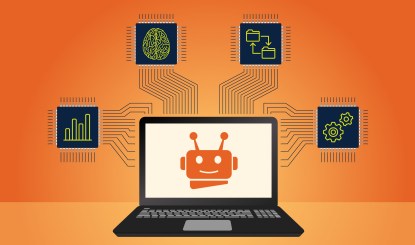Artificial Intelligence (AI) has become a critical component of the technology industry recently, and with good reason. Although there’s been some form of AI integrated into many of the digital tools organizations use, the advances in generative AI has led many organizations to look for new ways that the tools can be applied to everyday business problems so leaders can increase the productivity of their organization and its employees.
Process automation is something that’s been simultaneously sought after and feared as an idea for decades because it changes the way organizations have to operate to survive. Integrating AI into the process can expand the number of functions that businesses can automate and create more opportunities for employees to work on tasks that grow the business, but that doesn’t mean that every process is a candidate for AI-driven automation.
Here are a few of the key areas where organizations can take advantage of AI in the process of automating their organization:
Business Process Improvement
Business processes often become stymied in tradition, which can lead to inefficiencies over time. AI uses models that are able to learn the longer they’re used based on data the model gathers about the way processes unfold, which makes it ideal to update business processes for maximum impact.
For example, most businesses have some form of invoicing and if you’re working in an industry that’s relied on paper invoices or digital faxes, then there’s a real chance that you or your employees spend a significant amount of time processing those documents and reconciling them against payments you’ve received. This function is a perfect candidate for intelligent automation in the form of a Document Cognition or Document Understanding solution. Typically, developing a Document Cognition solution involves creating a RPA “bot” which carries out the repetitive tasks (such as opening the document, deploying a scanning and extraction tool like OCR, gathering and packaging the extracted data), and then connecting that with a learning model that becomes increasingly efficient in understanding the documents thrown its way. The more it sees, the easier it can make connections between the fields it is scanning and those it’s trained to look for, even if it has never seen the fields presented that way before.
Invoice processing is rules-based and repetitive, so creating a virtual bot that can scan the invoices and input the information into your database of choice can free up significant amounts of time your team may spend on data entry. However, RPA systems aren’t good at adjusting when a situation deviates from those set rules, and that’s where pairing it with an AI model can be particularly helpful. The reason is that AI learns from mistakes it makes, allowing it to adapt to exceptions to the rules an RPA tool would follow, and minimizing the interruptions in service it could experience if an invoice was torn or scuffed in a way that the bot on its own wouldn’t be able to recognize.
Data Governance
Any business has to collect information of some kind, but there always needs to be a series of controls in place that allows your organization to understand how that information is being used. Today, there are many different tools like Microsoft Purview (which you can find out more about here) that can provide insight into and control over who has access to your data. However, integrating an AI component into data governance tools will offer your organization a far more robust governance structure, as AI models could be used to analyze user behavior and guard against data misuse, predict exploitation before it occurs, and help identify vulnerabilities across vast sets of information.
Customer Sentiment
Understanding what your customers think about your business is a key aspect of success for any organization. After all, if customers feel generally that customer service at your organization is bad, then that’s a critical insight for leaders to know so they can adapt their processes, which is an area where AI can help.
AI models are able to pull information from many disparate sources, and in the case of measuring customer sentiments, they can be used to collect and analyze information from social media, review boards, RSS feeds, and more to help understand what the perception of your brand is. Further, with the advent of generative AI models, it can then generate recommendations on how to improve the customer experience and boost your organization’s overall brand sentiment as a consequence.
Apart from providing advice on how to improve brand sentiment, AI models are able to play a direct role in developing a positive experience. Most people have had some experience with automated phone systems, often leading to a level of frustration, but advances in generative AI and Large Language Models has created a more sophisticated generation of chat bots that can often provide basic customer service assistance. If the request falls outside the purview of a bot, then it can quickly triage the request to the correct employee so the client can get the service they want as quickly as possible.
Predictive Analytics
While every business is aware of the power of timing, leaders have often had to rely on data that’s been collected in the past to guess where things would go in the future. Extrapolating data can be difficult because there’s no process in the business world that can mathematically predict the outcome of a decision the way a physicist would be able to predict the acceleration of an apple falling from a tree.
However, AI will be able to create more educated guesses because models will be trained on massive data sets. Where business intelligence practitioners were previously limited in their ability to predict all possible outcomes of a decision, integrating AI into analytics platforms will enable the system to leverage patterns pulled from the historical data to determine what factors are most likely to influence outcomes. Hedge funds in particular have been utilizing algorithms for years to help understand how the markets will trend, but the advances in AI have enabled organizations of any size to take advantage of tools like this to gain insight into their data.
The Future of AI in Business
AI tools can boost the productivity for professionals of all kinds and improve the overall efficiency of most organizations. However, when applied improperly, AI can often create more problems than it solves, so it’s important to recognize why a tool should be replaced by an AI-powered one rather than applying it blindly and universally.
Being selective about how you apply AI to your business’s processes requires in-depth knowledge of how your workflows operate, what AI-driven tools exist, and how to leverage one to improve the other. Companies that try to plug any system into their business without first answering these questions will likely have more productivity problems than they did previously, because employees and customers won’t understand why they have so many more tools to navigate and will often resort to what they’ve known. Plus, if AI tools are deployed without necessary guardrails, checks and balances, or due attention to the policies that would govern it, it’s unlikely you’ll find out about a problem until it’s done significant damage to your enterprise.
If you’re looking for help with understanding where parts of your business’s processes can benefit from intelligent automation, contact us.



